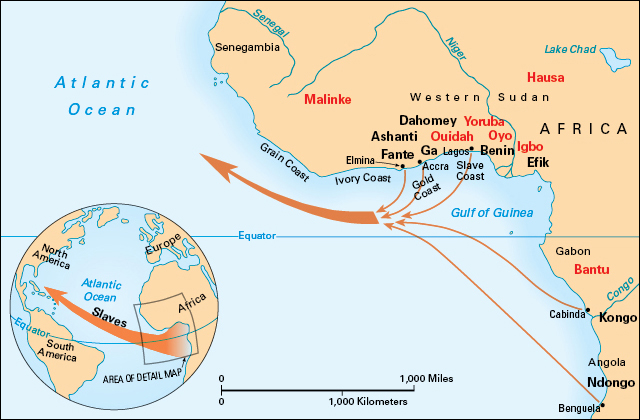Atlantic slave trade was the transport of enslaved people from Africa across the Atlantic Ocean to other lands from the mid-1400’s to the mid-1800’s. Although the first of the captive Africans were taken to Europe, most of them—between 10 million and 12 million—were transported to the Americas starting in the 1500’s. Many scholars recognize the Atlantic slave trade as the largest forced migration of people to that time.
In the 1400’s, Portuguese and Spanish traders began purchasing enslaved Africans from merchants on the west coast of Africa. The captives were taken to Europe to work as servants and laborers. In the 1500’s, after Portugal and Spain established colonies in the Americas, they brought enslaved Africans across the Atlantic Ocean to work in gold and silver mines and on sugar plantations throughout their territories. By the early 1600’s, the Dutch , French, and English also began to use African captives in their American colonies. The Europeans obtained enslaved people from Africans who traded or sold war captives and other prisoners for rum, cloth, and other items, including guns. The Africans wanted guns for use in wars fought with their neighbors to increase the number of captives they could sell. 
The Atlantic slave trade often took a triangular route. Ships from Europe transported goods to the West African coast. There, traders exchanged the goods for captured Africans. Next, the enslaved people were carried across the Atlantic Ocean to the Caribbean Islands and Brazil and sold for huge profits. This part of the route was called the Middle Passage because it was the middle leg of the journey from Africa to the New World . The traders used their earnings to buy sugar, coffee, and tobacco in the Americas. The ships then took these products to Europe.
The Atlantic slave trade was a profitable enterprise. The captains of slave ships therefore tried to deliver as many healthy captives for as little cost as possible. Some ship owners and operators used a system called loose packing to deliver their human cargo. Under that system, captains transported fewer people than their ships could carry in the hope of reducing sickness and death among them. Other captains preferred tight packing. They believed that many captives would die on the voyage anyway and so carried as many as their ships could hold.
Most slave ship voyages across the Atlantic took several months. The enslaved people were chained below deck except for brief periods of exercise. Their crowded conditions contributed to the chief horrors of the Middle Passage—filth, stench, disease, and the death of perhaps 1 million captive Africans.
The Atlantic slave trade consisted of approximately 35,000 transatlantic voyages from the early 1500’s to the mid-1800’s. The effects of the Atlantic slave trade on Africa were disastrous. Depopulation from raiding and warfare disrupted economic activities and development throughout much of Africa. The slave trade also contributed to the growth of racist stereotypes about Africans. Such stereotypes were used to justify their enslavement and the colonization of Africa by European powers.
See also Africa (The Atlantic slave trade) ; African Americans (Beginning of the slave trade) ; Slavery (Modern times) .
